 Nearly nine years ago, we published an article called "High Cost of Willfully Misinterpreting the 2nd Amendment." It highlighted the compelling U.S. Supreme Court dissents written by the late Justice John Paul Stevens and Justice Stephen Breyer in District of Columbia v. Heller (2008) --- a 5 - 4 decision in which the Court's right-wing majority overruled a 1939 SCOTUS precedent by ruling, for the first time in our nation's history, that the Second Amendment created an individual's right to possess a firearm unconnected to service in a State militia.
Nearly nine years ago, we published an article called "High Cost of Willfully Misinterpreting the 2nd Amendment." It highlighted the compelling U.S. Supreme Court dissents written by the late Justice John Paul Stevens and Justice Stephen Breyer in District of Columbia v. Heller (2008) --- a 5 - 4 decision in which the Court's right-wing majority overruled a 1939 SCOTUS precedent by ruling, for the first time in our nation's history, that the Second Amendment created an individual's right to possess a firearm unconnected to service in a State militia.
Our coverage was written against the backdrop of that year's midnight massacre where one individual, sporting body armor and an AR-15 assault rifle with a high-capacity, 100-round drum magazine capable of firing between 50-60 rounds/minute, murdered 16 people and wounded 58 inside an Aurora, CO movie theater. The 2012 article was also written against the backdrop of the large number of mass shootings within the U.S. that could, at that time, be sharply contrasted with what had transpired in Australia.
Following what became known as the 1996 Port Arthur Massacre in Australia --- where a lone gunman, sporting an AR-15, murdered 35 people --- the country enacted strict gun laws that included a gun buy-back program. The result: Australia did not experience a single mass shooting over the next 20 years.
Over these past nine years in this country, Congressional Republicans, who, in 2004, refused to extend the successful 1994 Assault Weapons Ban, continued to oppose any and all forms of gun safety legislation. Not coincidentally, the carnage wrought by the radical assertion of an unfettered individual "right" to bear arms helped lead to more than 600 mass shootings in the U.S. over the course of the 366 leap year days in 2020, according to a The New York Times database. There were, according to Wikipedia's Mass Shooting Tracker project, 150 U.S. mass shootings, producing 148 deaths while wounding 485, over the first 106 days in 2021.
With that in mind, as the unrelenting death toll mounts in the U.S., revisiting our earlier analysis is once again apropos...
Ignoring text, history and precedent
In his dissent in Heller, Justice John Paul Stevens observed:
The question before the Court in Heller was not new. It was squarely faced by the U.S. Supreme Court in U.S. v. Miller (1939), which upheld a conviction under the National Firearms Act of 1934 because there was no evidence to demonstrate that the use of a sawed-off shotgun bore a "reasonable relationship to the preservation or efficacy of a well regulated militia."
The Second Amendment states [emphasis added]: "A well regulated Militia, being necessary to the security of a free State, the right of the people to keep and bear Arms, shall not be infringed."
Stevens excoriated the majority for treating the preamble of the Second Amendment relating to a "well regulated militia" as if it were mere surplusage. "It cannot be presumed that any clause in the constitution is intended to be without effect." (Marbury v. Madison (1803).)
The first two clauses, "well regulated Militia" and "security of a free State" inform the meaning of the words "the people" in the third clause, Stevens proclaimed.
Stevens insisted that neither historical evidence nor the context of the language, taken as a whole, supports the conclusion that the Second Amendment was intended to secure to civilians the right to "keep and bear" arms for personal use. Indeed, he observed, quoting from the Oxford English dictionary, the words "bear arms" means "to serve as a soldier, do military service, fight."
Justice Breyer, in a separate dissent, added weight to the argument that the Second Amendment was never intended to prevent legislatures from passing gun control legislation "of great public importance, namely, saving lives, preventing injury, and reducing crime." He pointed out that, at the time the Second Amendment was passed, Boston, Philadelphia and New York had all placed restrictions on firing guns within city limits and had regulated "the storage of gunpowder, a necessary component of an operational fire arm."
Balancing rights
Even if we assume that the Court's right wing majority in Heller was correct --- that the framers of the 2nd Amendment intended to create an individual right to bear arms --- that doesn't mean that such a right outweighs the right of every citizen to go about their daily lawful activities free from the risk that their lives will be snuffed out by a mass murderer.
Our Courts have long recognized the need to balance conflicting rights. For example, the First Amendment guarantees the right to free speech, but that doesn't give you a right to falsely yell "fire" in a crowded theater or to "incite" an imminent violent act.
It is one thing to argue that the Second Amendment includes an individual right to bear arms. But it's patently absurd to suggest that an individual "right" to bear arms prevents passage of laws designed to protect the lives of the unarmed against the carnage wrought by mass murders.
 Ernest A. Canning is a retired attorney, author, and Vietnam Veteran (4th Infantry, Central Highlands 1968). He previously served as a Senior Advisor to Veterans For Bernie. Canning has been a member of the California state bar since 1977. In addition to a juris doctor, he has received both undergraduate and graduate degrees in political science. Follow him on twitter: @cann4ing
Ernest A. Canning is a retired attorney, author, and Vietnam Veteran (4th Infantry, Central Highlands 1968). He previously served as a Senior Advisor to Veterans For Bernie. Canning has been a member of the California state bar since 1977. In addition to a juris doctor, he has received both undergraduate and graduate degrees in political science. Follow him on twitter: @cann4ing


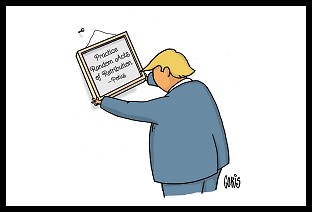 Sunday 'Random Acts of' Toons
Sunday 'Random Acts of' Toons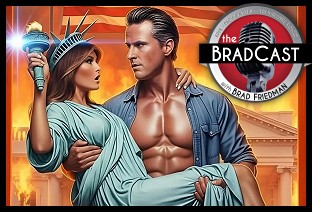 From CA's 'Nuclear Deterrence' Map to Newsom's Trolling to Trump's 'Fascist Theatre' and Beyond: 'BradCast' 8/21/25
From CA's 'Nuclear Deterrence' Map to Newsom's Trolling to Trump's 'Fascist Theatre' and Beyond: 'BradCast' 8/21/25 'Green News Report' 8/21/25
'Green News Report' 8/21/25
 On 'Americanism' and Trump's 'Stalinesque' Plot to Whitewash U.S. History: 'BradCast' 8/20/25
On 'Americanism' and Trump's 'Stalinesque' Plot to Whitewash U.S. History: 'BradCast' 8/20/25 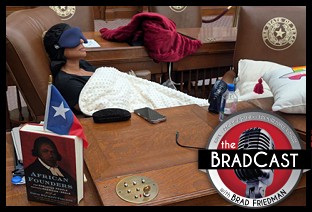 Texas GOP Imprisons Dem State Lawmaker in State House Chamber: 'BradCast' 8/19/25
Texas GOP Imprisons Dem State Lawmaker in State House Chamber: 'BradCast' 8/19/25 'Green News Report' 8/19/25
'Green News Report' 8/19/25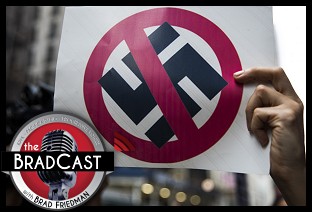 Trump, Nazis and
Trump, Nazis and  Sunday '
Sunday ' Newsom's 'Election Rigging Response Act'; FCC's License Renewal for Sock-Puppeting Sinclair: 'BradCast' 8/14/25
Newsom's 'Election Rigging Response Act'; FCC's License Renewal for Sock-Puppeting Sinclair: 'BradCast' 8/14/25 'Green News Report' 8/14/25
'Green News Report' 8/14/25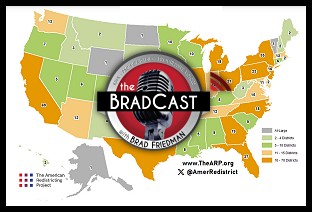 140 New House Reps?: Moving Beyond the Gerrymandering Wars: 'BradCast' 8/13/25
140 New House Reps?: Moving Beyond the Gerrymandering Wars: 'BradCast' 8/13/25 FCC Renews Sinclair TV Licenses Despite Complaint from Petitioner Who Died Waiting
FCC Renews Sinclair TV Licenses Despite Complaint from Petitioner Who Died Waiting It's Not About the Rule of Law, It's About Authoritarian Control: 'BradCast' 8/12/25
It's Not About the Rule of Law, It's About Authoritarian Control: 'BradCast' 8/12/25 'Green News Report' 8/12/25
'Green News Report' 8/12/25 After Vaccine Cancels, CDC Shooting, Former Officials Want RFK Out: 'BradCast' 8/11/25
After Vaccine Cancels, CDC Shooting, Former Officials Want RFK Out: 'BradCast' 8/11/25 Sunday 'All's Well' Toons
Sunday 'All's Well' Toons 'Green News Report' 8/7/25
'Green News Report' 8/7/25 Trump Wars Against Greem Energy, Democracy on VRA's 60th: 'BradCast' 8/7
Trump Wars Against Greem Energy, Democracy on VRA's 60th: 'BradCast' 8/7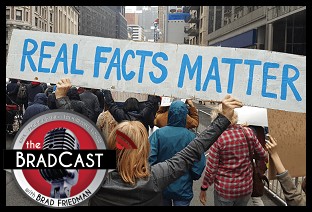 Media Conglomerates Continue Trump Capitulation: 'BradCast' 8/6/25
Media Conglomerates Continue Trump Capitulation: 'BradCast' 8/6/25 Banana Republican: Trump Shoots the Labor Statistics Messenger: 'BradCast' 8/5/25
Banana Republican: Trump Shoots the Labor Statistics Messenger: 'BradCast' 8/5/25 All's Fair in Love, War and, Apparently, Part-isan Gerrymandering: 'BradCast' 8/4/25
All's Fair in Love, War and, Apparently, Part-isan Gerrymandering: 'BradCast' 8/4/25 The Art of the Corrupt, Phony, Unlawful, Pretend Trade Deal: 'BradCast' 7/31/25
The Art of the Corrupt, Phony, Unlawful, Pretend Trade Deal: 'BradCast' 7/31/25 Battle Begins Against Trump EPA Climate Regulations 'Kill Shot': 'BradCast' 7/30/25
Battle Begins Against Trump EPA Climate Regulations 'Kill Shot': 'BradCast' 7/30/25 A Pu Pu Platter of Trump Corruption: 'BradCast' 7/29/25
A Pu Pu Platter of Trump Corruption: 'BradCast' 7/29/25 'Catastrophic' GOP Cuts to Medicaid, Medicare, ACA: 'BradCast' 7/28/25
'Catastrophic' GOP Cuts to Medicaid, Medicare, ACA: 'BradCast' 7/28/25
 VA GOP VOTER REG FRAUDSTER OFF HOOK
VA GOP VOTER REG FRAUDSTER OFF HOOK Criminal GOP Voter Registration Fraud Probe Expanding in VA
Criminal GOP Voter Registration Fraud Probe Expanding in VA DOJ PROBE SOUGHT AFTER VA ARREST
DOJ PROBE SOUGHT AFTER VA ARREST Arrest in VA: GOP Voter Reg Scandal Widens
Arrest in VA: GOP Voter Reg Scandal Widens ALL TOGETHER: ROVE, SPROUL, KOCHS, RNC
ALL TOGETHER: ROVE, SPROUL, KOCHS, RNC LATimes: RNC's 'Fired' Sproul Working for Repubs in 'as Many as 30 States'
LATimes: RNC's 'Fired' Sproul Working for Repubs in 'as Many as 30 States' 'Fired' Sproul Group 'Cloned', Still Working for Republicans in At Least 10 States
'Fired' Sproul Group 'Cloned', Still Working for Republicans in At Least 10 States FINALLY: FOX ON GOP REG FRAUD SCANDAL
FINALLY: FOX ON GOP REG FRAUD SCANDAL COLORADO FOLLOWS FLORIDA WITH GOP CRIMINAL INVESTIGATION
COLORADO FOLLOWS FLORIDA WITH GOP CRIMINAL INVESTIGATION CRIMINAL PROBE LAUNCHED INTO GOP VOTER REGISTRATION FRAUD SCANDAL IN FL
CRIMINAL PROBE LAUNCHED INTO GOP VOTER REGISTRATION FRAUD SCANDAL IN FL Brad Breaks PA Photo ID & GOP Registration Fraud Scandal News on Hartmann TV
Brad Breaks PA Photo ID & GOP Registration Fraud Scandal News on Hartmann TV  CAUGHT ON TAPE: COORDINATED NATIONWIDE GOP VOTER REG SCAM
CAUGHT ON TAPE: COORDINATED NATIONWIDE GOP VOTER REG SCAM CRIMINAL ELECTION FRAUD COMPLAINT FILED AGAINST GOP 'FRAUD' FIRM
CRIMINAL ELECTION FRAUD COMPLAINT FILED AGAINST GOP 'FRAUD' FIRM RICK SCOTT GETS ROLLED IN GOP REGISTRATION FRAUD SCANDAL
RICK SCOTT GETS ROLLED IN GOP REGISTRATION FRAUD SCANDAL VIDEO: Brad Breaks GOP Reg Fraud Scandal on Hartmann TV
VIDEO: Brad Breaks GOP Reg Fraud Scandal on Hartmann TV RNC FIRES NATIONAL VOTER REGISTRATION FIRM FOR FRAUD
RNC FIRES NATIONAL VOTER REGISTRATION FIRM FOR FRAUD EXCLUSIVE: Intvw w/ FL Official Who First Discovered GOP Reg Fraud
EXCLUSIVE: Intvw w/ FL Official Who First Discovered GOP Reg Fraud GOP REGISTRATION FRAUD FOUND IN FL
GOP REGISTRATION FRAUD FOUND IN FL

































